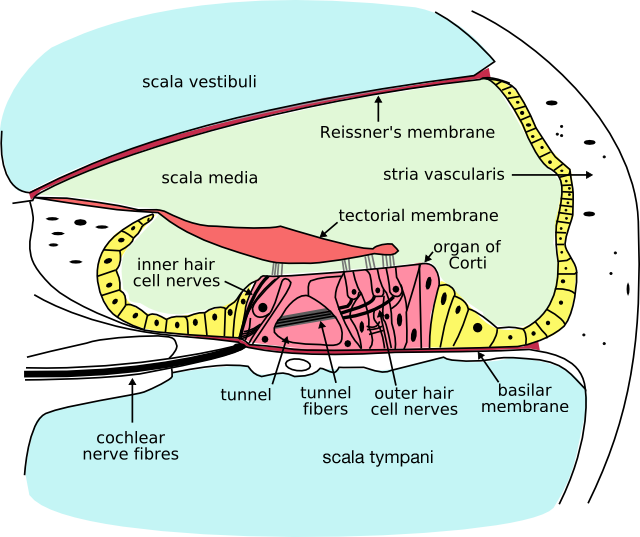Hyperbaric Oxygen Therapy's Newest Approved Indication
November 11, 2014
By Lindsay D. Andronaco RN, BSN, CWCN, WOC, DAPWCA, FAACWS
Sudden hearing loss affects 5-20 individuals per 100,000, which equates to about 4,000 new cases each year in the U.S. Idiopathic Sudden Sensorineural Hearing Loss, or ISSHL, is spontaneous hearing loss in one or both ears with no apparent or known cause. This condition requires urgent medical attention.
An Overview of Idiopathic Sudden Sensorineural Hearing Loss
ISSHL is the newest indication approved by the Undersea and Hyperbaric Medical Society's Hyperbaric Oxygen Therapy Committee (approved on October 8, 2011). ISSHL appears to be characterized by hypoxia in the perilymph and therefore the scala tympani and the organ of Corti. The rationale for the use of hyperbaric oxygen therapy (HBOT) and corticosteroids to treat ISSHL is based on the high metabolism and poor vascularity of the cochlea. The cochlea and the structures within it, particularly the stria vascularis and the organ of Corti, require a high oxygen supply. Corticosteroids improve ISSHL by decreasing inflammation and edema, while HBOT increases tissue oxygenation and improves outcomes.

A cross-section of the cochlea, with the scala tympani and the organ of Corti labeled. [From Wikimedia Commons]
Clinical Support for Using Hyperbaric Oxygen Therapy for ISSHL
A review of the literature reveals more than 100 publications evaluating the use of HBOT for the treatment of ISSHL, including eight randomized controlled trials (RCTs). HBOT is also the only reviewed ISSHL treatment found by the Cochrane Review to be effective. The best and most consistent results are obtained when HBOT is initiated within two weeks of symptom onset and combined with corticosteroid treatment. Those younger than 60 years old have the greatest chances of regaining their hearing. The average hearing gain is 19.3 dB for moderate hearing loss and 37.7 dB for severe cases.
This improvement brings hearing deficits from the moderate/severe range into the slight/no impairment range. This is a significant gain that can markedly improve a patient's quality of life, both clinically and functionally. Although starting HBOT within two weeks is preferred, The American Academy of Otolaryngology - Head and Neck Surgery guidelines recommend that HBOT be considered as a treatment up to three months from symptoms onset.
Other Approved Indications for Hyperbaric Oxygen Therapy
HBOT is also indicated for use as an adjunctive therapy in the treatment of a number of conditions. In wound care, HBOT is approved for use in treatment of the following:
- Arterial insufficiencies
- Enhancement of healing in selected problem wounds
- Necrotizing soft tissue infections
- Osteomyelitis (refractory)
- Delayed radiation injury (soft tissue and bony necrosis)
- Compromised grafts and flaps
- Acute thermal burn injury
Click here to view my blog containing a comprehensive list of all of the approved indications for HBOT.
Sources
Bennett MH, Kertesz T, Perleth M, Yeung P, Lehm JP. Hyperbaric oxygen for idiopathic sudden sensorineural hearing loss and tinnitus. Cochrane Database Syst Rev. 2012;10:CD004739. doi: 10.1002/14651858.CD004739.pub4.
Murphy-Lavoie H, Piper S, Moon RE, Legros T. Hyperbaric oxygen therapy for idiopathic sudden sensorineural hearing loss. Undersea Hyperb Med. 2012;39(3):777-92.
Stachler RJ, Chandrasekhar SS, Archer SM, et al. Clinical practice guideline: sudden hearing loss. Otolaryngol Head Neck Surg. 2012;146(supplement 3):S1–S35.
American Academy of Otolaryngology-Head and Neck Surgery
About the Author
Lindsay (Prussman) Andronaco is board certified in wound care by the Wound Ostomy Continence Nursing Certification Board. She also is a Diplomate for the American Professional Wound Care Association. Her clinical focus is working with Diabetic Limb Salvage/Surgical/Plastic Reconstruction patients, though her interests and experience are varied and include surgical, urological and burn care, biotherapeutics and Kennedy Terminal Ulcer research. Lindsay is the 2011 recipient of the Dorland Health People's Award in the category of 'Wound Ostomy Continence nurse' and has been recognized in Case In Point Magazine as being one of the "Top People in Healthcare" for her "passionate leadership and an overall holistic approach to medicine."
Lindsay is board certified in wound care by the Wound Ostomy Continence Nursing Certification Board. She also is a Diplomate for the American Professional Wound Care Association. In 2011, Lindsay was honored with the Dorland Health People's Award in the category of 'Wound Ostomy Continence nurse.'
The views and opinions expressed in this blog are solely those of the author, and do not represent the views of WoundSource, Kestrel Health Information, Inc., its affiliates, or subsidiary companies.
The views and opinions expressed in this blog are solely those of the author, and do not represent the views of WoundSource, HMP Global, its affiliates, or subsidiary companies.








Follow WoundSource
Tweets by WoundSource